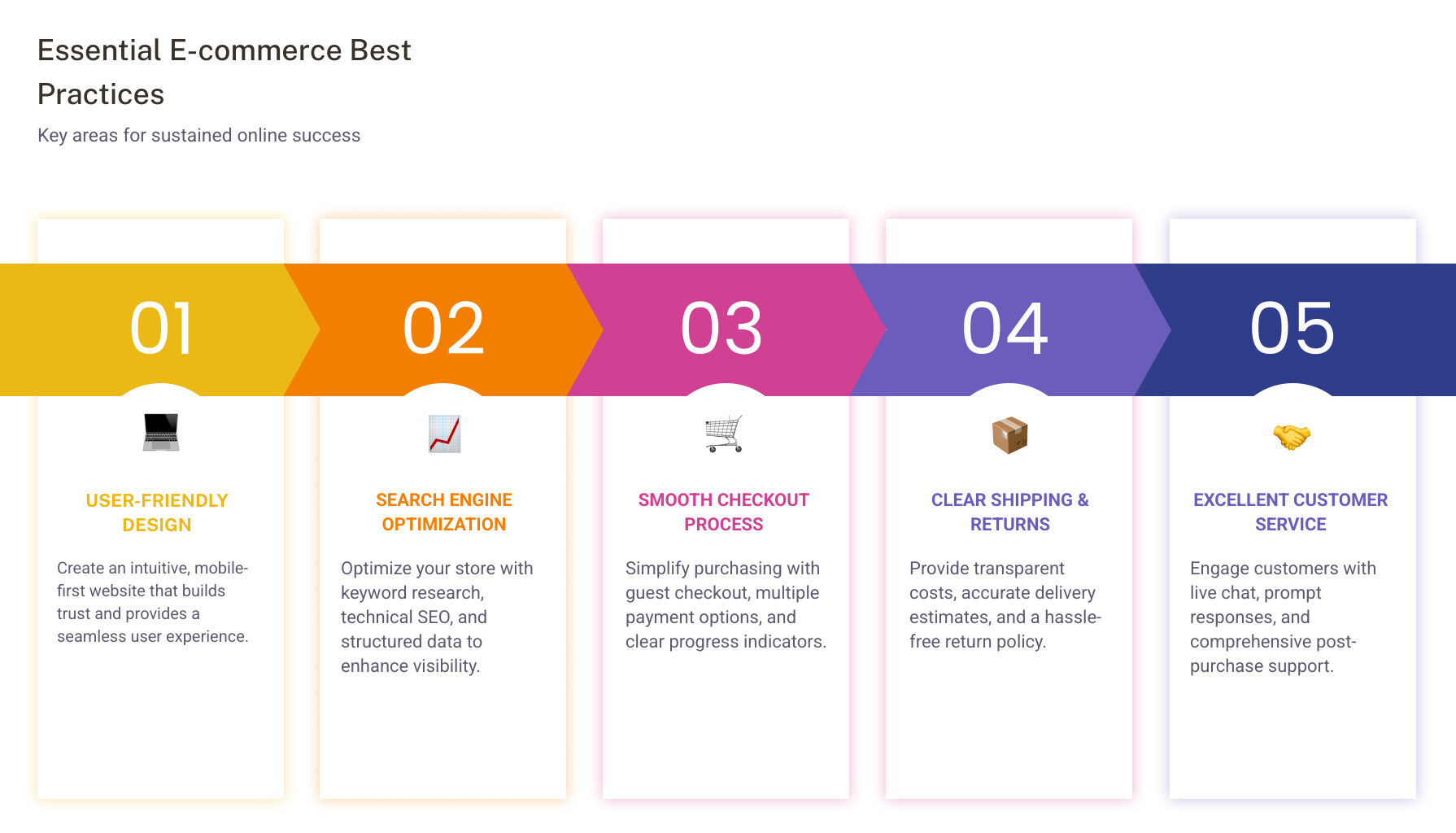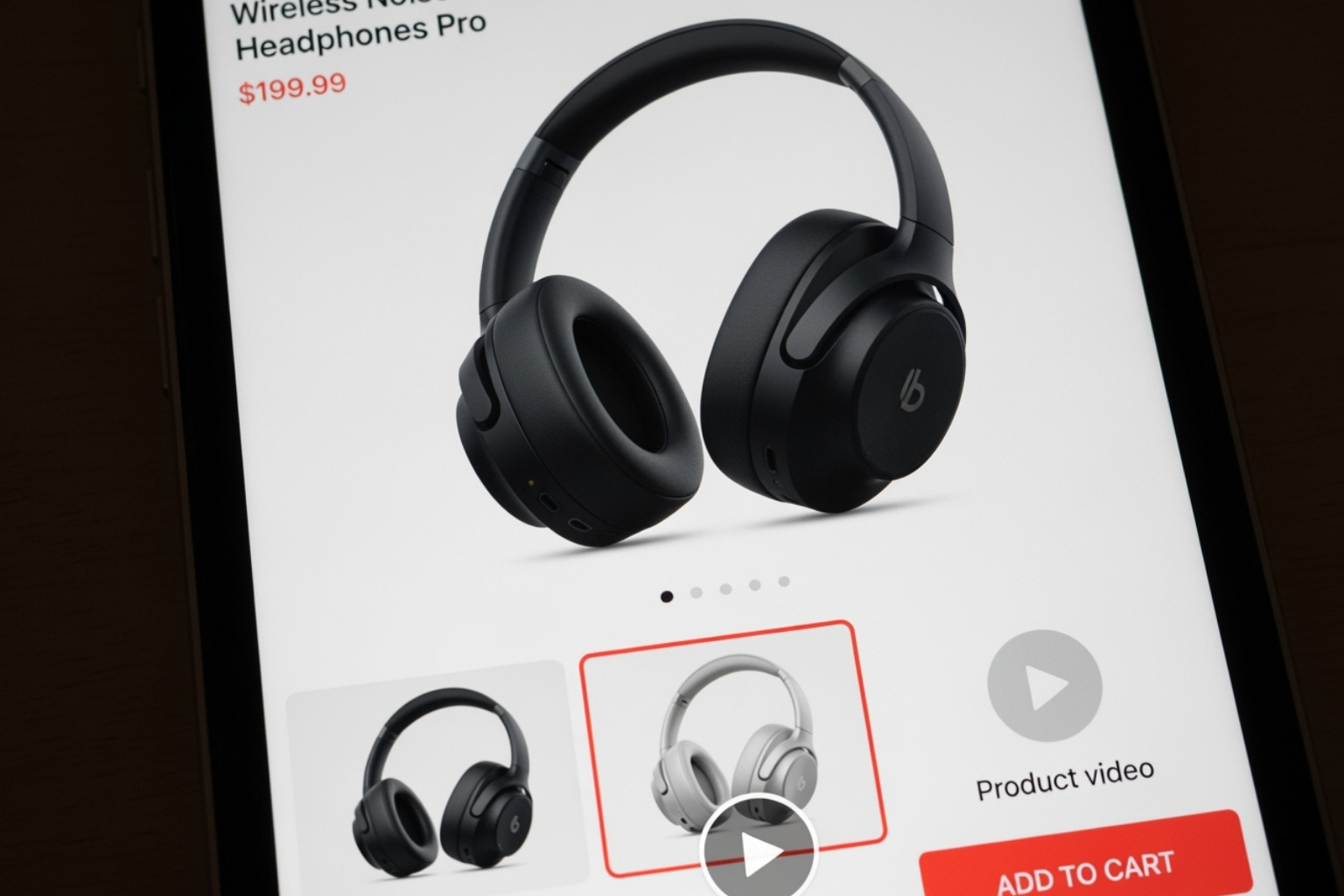Build a User-Friendly and Trustworthy Website
To succeed online, focus on these e-commerce best practices:
- User-Friendly Website Design: A clear, easy-to-use, and trustworthy online store.
- Search Engine Optimization (SEO): Helping customers find you through search engines.
- Effective Product Presentation: Great images and descriptions that show off your products.
- Smooth Checkout Process: An easy and quick buying process to reduce abandoned carts.
- Clear Shipping & Returns: Transparent and fair delivery and return policies.
- Customer Involvement: Lasting relationships through great service and communication.
- Data Analysis: Using numbers to understand customers and improve your business.
- Staying Current: Keeping up with new technologies and shopping trends.
For businesses to thrive online, using e-commerce best practices is essential. These are proven strategies that help your store stand out. You have about 50 milliseconds to make a good first impression, and these practices help you do just that, leading to more sales and happier customers.
My name is Steve Pogson. As a Shopify Expert and E-commerce Growth Specialist with over 20 years of experience, I've helped online businesses succeed by focusing on these core practices. Our team at First Pier is dedicated to enabling businesses with effective solutions to grow.

E-commerce best practices terminology:
1. Prioritize Clean and Intuitive Web Design
When someone lands on your site, you have milliseconds to make an impression. It takes just 50 milliseconds for visitors to decide if they'll stay. My goal is to make that first glance count. A simple design reduces clutter, allowing your products and promotions to be front and center.
I focus on creating a simplified user experience with easy navigation and a clear visual hierarchy. If visitors have to work to find what they want, they'll likely leave. A consistent brand image, from colors to fonts, is also important for building familiarity and trust.
2. Make Your Site Mobile-Responsive
Mobile shopping is huge. In fact, 76% of consumers shop on mobile devices, and mobile e-commerce is predicted to account for 40% of all e-commerce sales this year. If your site isn't ready for mobile, you're missing out on many potential customers.
I ensure a website offers a seamless experience across all devices, from desktops to smartphones. This includes using responsive themes that adapt to different screen sizes and prioritizing fast mobile loading times. A smooth mobile experience is essential.
More info about Shopify Accessibility Best Practices
3. Build Trust with Social Proof and Security
Online, trust is gold. Only 52% of consumers trust companies, and nearly three-fourths of fraud cases involve e-commerce merchants. I build trust using a combination of social proof and visible security measures.
Customer reviews are powerful; 95% of customers read them before buying, and social proof can boost conversions by 34%. I encourage displaying genuine testimonials and user-generated content. Beyond reviews, I make sure your site has clear contact information, a detailed 'About Us' page, and trust badges like SSL certificates and payment provider logos. These signals reassure customers that their information is safe and you're a legitimate business.

Optimize Your Store with Technical E-commerce Best Practices
With a great-looking, trustworthy site, it's time to focus on the technical elements. These e-commerce best practices work behind the scenes to make sure your store runs smoothly, drawing in customers and keeping them happy.
4. Boost Your Website Speed
Just like a physical store with slow doors, a slow website will turn customers away. Speed matters a lot. A 1-second delay in page load time can cause a 7% drop in your conversion rate. For a business earning $100,000 a day, that's a potential loss of $2.5 million in sales annually. Most customers expect a page to load in two seconds or less. If your site is slow, they'll be gone.
That's why I focus on making your website lightning-fast. This involves technical work like compressing images so they load quickly, using browser caching for returning visitors, and minifying code to make it leaner. We also ensure you have reliable hosting that can handle traffic spikes. These adjustments make a huge difference to your bottom line.
More info about Shopify Speed Optimization Guide
5. Master Foundational E-commerce SEO
An amazing store is useless if no one can find it. That's where Search Engine Optimization (SEO) comes in. My approach to e-commerce SEO is more than just adding keywords; I make your entire site easy for search engines to understand, which helps shoppers find you.
This starts with keyword research to know what customers are searching for. Then, we write unique and compelling product descriptions and optimize category pages. We also handle technical SEO, like creating sitemaps, managing robots.txt files, and using structured data (Schema.org). This special code gives search engines detailed product information, helping your products show up in search results with extras like star ratings or prices, making your listing more appealing.
More info about Understanding Ecommerce SEO
6. Implement Powerful On-Site Search
When customers arrive on your site, I help them find what they want fast. Visitors who use your on-site search convert at almost double the rate of those who don't. Research from Forrester shows that 43% of website visitors go straight to the internal search bar. It's a clear signal of intent, and you want to make that experience as smooth as possible.
That's why I make sure the search bar is highly visible. We add helpful features like autocomplete, which guesses what users are typing, and clever filters and sorting options to help them narrow down results. If a search finds no results, your site should offer helpful suggestions for related products or categories. Analyzing on-site searches also gives incredible insight into customer wants, which helps improve product pages and content. It's like a direct line to their shopping minds!
Research from Forrester on site search
Improve Product Presentation and Streamline the Sale
7. Use High-Quality Product Images and Videos
Online, customers can't touch your products, so images are your most powerful sales tool. A surprising 67% of online shoppers find images more important than reviews or descriptions.
Think of product photos as silent salespeople. Use at least 3 to 5 high-quality images for each product, showing different angles and details, and include a zoom feature.
Lifestyle shots help customers picture themselves using the product, creating an emotional connection that plain product shots can't. For example, show someone wearing a cozy sweater while sipping coffee.
For complex or pricey items, add 360-degree views or product videos. A customer spending $200 wants to see every angle. Product videos are powerful because they show your item in action, building confidence and trust.

67% of online shoppers find images important
8. Write Compelling and Detailed Product Descriptions
While images grab attention, product descriptions seal the deal. On a typical Amazon page, customers spend only 18% of their time on photos and the rest reading text, showing how crucial good descriptions are.
I write descriptions that go beyond just listing features. Mention key features and specifications, but also talk about the benefits. If you're selling a backpack, explain how its compartments help people stay organized.
Address potential questions about sizing information, materials, or care instructions. Answering questions upfront builds buying confidence.
Don't forget to add some personality. Storytelling can be very powerful, helping customers imagine themselves using and enjoying your product.
More info about Shopify Product Page SEO
9. Simplify the Checkout Process
Your checkout process is the final hurdle, so it must be smooth. 48% of customers abandon carts due to high extra costs. Others leave because of slow delivery, a complex process, or trust issues.
I always recommend offering a guest checkout option. Don't force people to create an account. Use a progress indicator so customers know where they are in the process.
Keep your form fields to a minimum. Only ask for what you need to complete the order. Every extra field is another reason for someone to leave.
Multiple payment options are essential. Offer credit cards, digital wallets like Apple Pay, and Buy Now, Pay Later services. More than half of commerce leaders offer these options because they reduce friction. With mobile transactions at $2.2 trillion and digital wallet use growing 62%, make it easy for people to pay.
The key to e-commerce best practices in checkout is simple: remove every possible obstacle.
More info about Shopify Conversion Rate Optimization (CRO) Checklist
Fulfill Orders and Develop Long-Term Loyalty
10. Develop a Clear Shipping and Returns Strategy
Getting the sale isn't the end of the customer's experience. Unexpected costs can derail a purchase. Nearly half of customers abandon orders due to surprise costs. That's why I stress being clear about shipping costs and estimated delivery dates from the start. Transparency helps.
Consider offering a free shipping threshold. This can encourage customers to add more to their cart, boosting your average order value.
Returns are another key piece. 91% of customers check the returns policy before buying from a new brand. I help businesses create easy-to-find, hassle-free return policies. This builds confidence and trust. With 73% of consumers thinking about the environment, eco-friendly return solutions can also be a great way to connect with your audience.
More info about Ecommerce Shipping Optimization
11. Involve Customers with Email and SMS Marketing
A purchase is the start of a customer relationship. Building loyalty is key, and email and SMS marketing are great tools. Email marketing is a powerhouse; 81% of small businesses use it for new customers, with some reporting a 40x return. It drives 7% of all e-commerce transactions.
I help businesses set up automated messages like abandoned cart reminders, welcome series for new subscribers, promotional campaigns, and loyalty program updates.
Personalization and segmentation are key. Sending the right message to the right person at the right time makes customers feel valued and more likely to return. These are vital e-commerce best practices for building a loyal customer base.
More info about Email Marketing for Ecommerce
12. Provide Excellent Customer Service
Great customer service is a critical e-commerce best practice for building loyalty. When customers have a positive experience, 89% are likely to buy again.
Live chat is a very effective tool. It can boost sales by 20% and order values by 15%. Responding within five minutes makes closing a sale 69% more likely. It shows you're there for them.
Beyond live chat, ensure you have accessible contact information, a detailed FAQ page, and a system for prompt responses. Post-purchase support, like easy access to tracking updates and order history, also makes a big difference. Over half of businesses (53%) even let service agents place orders for customers, making the entire experience smooth.
More info about Improving Customer Retention & Loyalty
Use Data and Prepare for the Future
13. Use Data and Analytics to Make Decisions
For your online store, don't guess—measure. Using data is a key e-commerce best practice to understand what's working.
Tools like Google Analytics help you track key metrics like conversion rate, average order value (AOV), and customer lifetime value (CLV).
This data shows customer behavior. For instance, visitors using site search convert at nearly double the rate of those who don't—a huge clue to improve your search feature. We also use heatmaps to see where people click and A/B testing to try different page layouts. Regular A/B testing can increase revenue by up to 49% per visitor. Making data-driven choices is always smart.
More info about Ecommerce Data Analytics
14. Personalize the Customer Experience
Online shoppers want a personal touch. 71% of consumers expect a personalized experience, and businesses that provide it see up to 40% more revenue.
It's about making each customer feel known. I help stores set up personalized recommendations based on browsing or purchase history. This can include targeted promotions, dynamic content, or smart customer segmentation for relevant messages.
59% of shoppers find it easier to find products on personalized stores, and 56% are more likely to return. A custom experience helps customers connect with your brand and encourages them to buy.
More info about How to Increase Average Order Value (AOV)
15. Keep an Eye on Emerging Trends
The online shopping world is always changing. Staying on top of new trends and technologies is key to long-term success.
Here are some trends to watch:
- Mobile commerce: Global mobile transactions reached $2.2 trillion last year.
- Voice search: Over 25% of people worldwide use voice search on mobile.
- Social commerce: Over half (51%) of businesses now sell through social media.
- Artificial Intelligence (AI): Generative AI is becoming a standard for personalizing experiences.
- Augmented Reality (AR): Lets customers "try on" products virtually.
- Recommerce: The market for selling pre-owned items is growing.
- Sustainability: 73% of consumers are willing to change shopping habits to help the environment.
By understanding and using these changes, you can give your business an advantage.
More info about the Role of AI in E-commerce
Frequently Asked Questions about E-commerce Best Practices
What is the most important factor for e-commerce success?
There isn't one single most important factor. A successful online store is like a machine where all parts must work together. But if I had to pick one concept, it's the customer experience.
Everything from site speed to ease of navigation contributes to this. A user-friendly design, fast loading, a trustworthy environment, great product showcases, a seamless checkout, and excellent customer service all work together. These e-commerce best practices create a positive experience, leading to more sales and loyal customers. Without it, even great products can fail.
How can I reduce my shopping cart abandonment rate?
Cart abandonment is a common challenge, often caused by surprises or a difficult process. Here’s what helps:
First, be clear about all costs. Customers dislike hidden fees. Nearly half (48%) will leave if they see unexpected costs like shipping late in the process. Be upfront about these costs early.
Next, simplify your checkout. Offer a guest checkout option instead of forcing account creation. Minimize form fields and use a progress indicator. A complex checkout deters about 25% of buyers.
Also, offer multiple payment options, including digital wallets and "Buy Now, Pay Later." 9% of customers abandon carts if their preferred method is missing. Show trust signals like security badges and clear contact info to reassure customers.
Finally, review your shipping strategy. Provide clear delivery estimates and consider a free shipping threshold to encourage larger orders. For those who still abandon their carts, use abandoned cart emails as a gentle reminder, maybe with a small incentive.
How often should I update my e-commerce website?
Your e-commerce site is a living thing, not a static brochure. It needs constant attention to succeed. The online world changes fast; what worked last year might not work today. SEO, for instance, is always changing.
I advise regular updates. They don't need to be huge overhauls, just consistent improvements. Monitor your site's performance: check loading speed, mobile functionality, and security.
Continuously improve your user experience (UX). Use analytics to find where customers get stuck and A/B test new page ideas. Keep your content fresh with updated product descriptions, new blog posts, and a helpful FAQ section.
Watch for emerging trends like AI, voice search, and new payment methods. Staying current gives you an edge. Regularly update your platform and plugins for security. Small, consistent improvements are more effective than a huge revamp every few years.
To Sum Up
E-commerce success is about consistently using proven e-commerce best practices that put customers first. It's like building a house: you need a solid foundation (a fast, trustworthy site), strong walls (great product presentation and checkout), and a welcoming atmosphere (excellent service and personalized experiences).
This guide covered what separates successful stores from struggling ones. Clean design makes a great first impression, and mobile optimization is vital with 76% of consumers on their phones. Trust from social proof and security badges gives customers confidence, and fast loading speeds keep them on your site.
A solid technical foundation is also key. Good SEO helps customers find you, and effective on-site search helps them find what they want. Combine these with high-quality images, compelling descriptions, and a smooth checkout for success.
The relationship continues after checkout. Clear shipping policies, involving email marketing, and responsive customer service build loyalty. Using data and personalizing the experience helps you improve and stay competitive.
The e-commerce world keeps changing with new tech like AI and new customer expectations. Successful businesses stay curious, test new ideas, and always improve the customer experience.
Using e-commerce best practices is a marathon, not a sprint. Small, consistent improvements based on data and feedback are better than trying to do everything at once.
Ready to improve your store's design and user experience? Explore our Ecommerce UX Design services.







